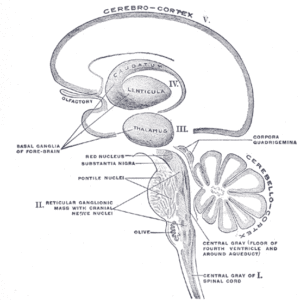by Leza Lowitz

In my most recent post on Empress pose, I mentioned that when we bring the chin toward the chest, we deactivate the Reticular Activating System (RAS). Many of you were probably wondering what the RAS is, so I thought today I’d explain more about what it is and why dialing it down can be so beneficial in a restorative yoga practice.
Physically the RAS is a bundle of nerves at our brainstem that projects anteriorly to the hypothalamus to mediate behavior, posteriorly to the thalamus, and directly to the cortex to activate awake EEG patterns. This illustrates shows the reticular ganglionic mass at the top of the brainstem.

This network of neurons receives input from your visceral, somatic, and sensory systems to filter out unnecessary information so that the important information gets through. The RAS is the reason you learn a new word and then start hearing it everywhere. It’s why you can tune out a crowd full of talking people, yet immediately snap to attention when someone says your name (or something that might sound like it).
In his 2015 paper, Waking and the Reticular Activating System in Health and Disease, Dr. Edgar Garcia-Rill also notes that the RAS controls sleep and waking as well as our fight-flight-or-freeze responses. “While this system provides signals that modulate our wake-sleep states, it also serves to help us respond to the world around us,” he writes. “For example, strong stimuli simultaneously activate ascending RAS projections to the thalamus and then the cortex and cause arousal and also activate descending projections that influence the spinal cord in the form of postural changes in tone resulting from the startle response, as well as trigger locomotor events in fight-or-flight responses.“ This is why dialing down the RAS can de-activate the fight-flight-or-freeze response and activate the rest-and-digest response. The parasympathetic nervous system can then become dominant, decreasing hypertension, stress, depression and anxiety, and increasing our overall health and well-being.
Garcia-Rill adds that the RAS “…supplies the “context” of sensory experience during waking.” In other words, the RAS takes what you focus on and creates a filter for it. It then sifts through the data and presents only the pieces that are important to you. All of this happens without your awareness of it, of course. The RAS programs itself to work in your favor without you actively doing anything.
The RAS finds information that validates your beliefs. It filters the world through the parameters you give it, and your beliefs about yourself and the world shape those parameters. For example, if you think you’re bad at something, you probably will be. On the other hand, if you believe you are effective at something, you most likely are. The RAS helps you see what you want to see, and in doing so, it influences your actions. Kind of like a self-fulfilling prophecy.
Because of our anatomy, bringing the toward chin toward the chest stimulates two important glands, the thyroid and the parathyroid, which help to regulate metabolism. It also helps dial down the RAS system—which keeps the eyes open and keeps the mind working (and busy!). Shutting off our “mental executive assistant” essentially turns down the fight-flight or freeze response and activates our parasympathetic dominance. When the body-mind is in a state of parasympathetic dominance, the mind will tilt toward ease and peace rather than struggle and fear. This leads to better digestion, better sleep, and better functioning all around.
By the way, bringing your chin toward your chest stimulates the baroreceptors in your carotid sinus, which can also enhance the pose’s calming effects (see More Love for Your Baroreceptors: Supporting Your Head in Restorative Poses).
Four Tips for Turning Off the RAS
- Make sure your neck is not in in a backbend (hyperextension) and support your head and neck with a rolled-up towel, folded blanket, or neck pillow. If your neck is tight, it is particularly hard to point the chin toward the chest, so make sure to have ample support. After supporting your head, gently move your chin toward your chest to deactivate the RAS. This turns off thinking mind (DOING) and turns on BEING. Just surrendering to WHAT IS rather than thinking, planning, or trying to control WHAT WAS or WHAT WILL BE.
- Supported postures bring emotional release as well as physical comfort. So make sure that you are feeling safe and contained. One way to feel safe is to ensure that you will be in a secure, quiet, warm place where you will be undisturbed for the duration of your practice. So try covering yourself with a blanket and practicing with your back and/or feet against a wall or blocks to feel held and supported. Some people find using a weighted blanket helpful in this regard.
- Set an intention to positively direct the RAS before it switches off. Yogis believe we can train the RAS by taking our subconscious thoughts and marrying them to our conscious thoughts. We call this sankalpa, or “setting your intention.” If you focus your mind on a goal or intention, the RAS can help reveal the people, information, and opportunities that could aid you in realizing this intention. Examples of intentions you might set are to be at peace, to feel contentment, to have acceptance. Once your intention is set, surrender and let go of trying to control the outcome.
- Breathe into your belly and soften, noticing any physical sensations, thoughts or emotions that arise. Allow them to be just as they are, without judgment. Hold whatever arises in compassionate awareness, relaxing into sensation.
You can read more about Leza’s writing at www.lezalowitz.com and about her yoga studio and classes at www.sunandmoon.jp.
Follow Yoga for Healthy Aging on Facebook ° To order Yoga for Healthy Aging: A Guide to Lifelong Well-Being, go to Amazon, Shambhala, Indie Bound or your local bookstore.


Leave A Comment